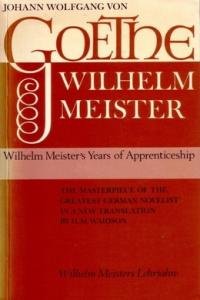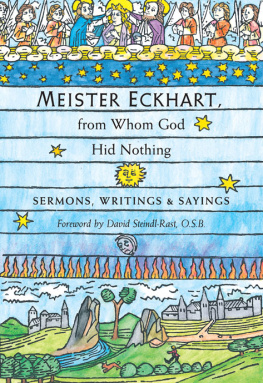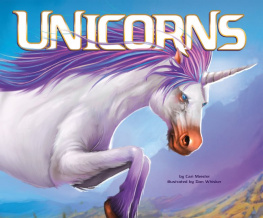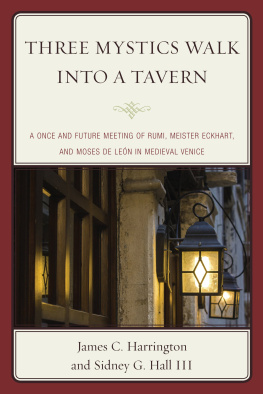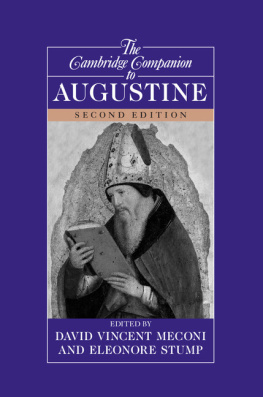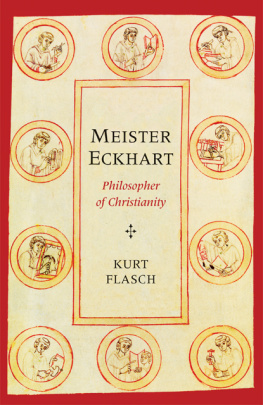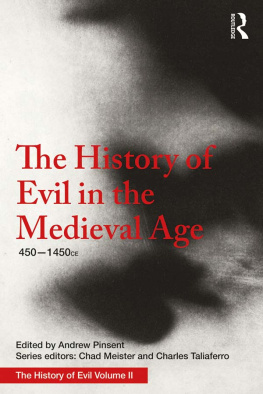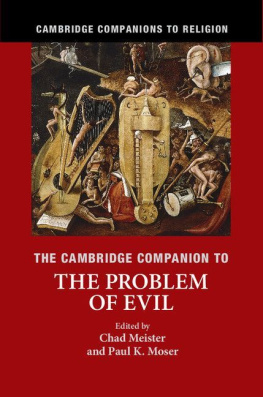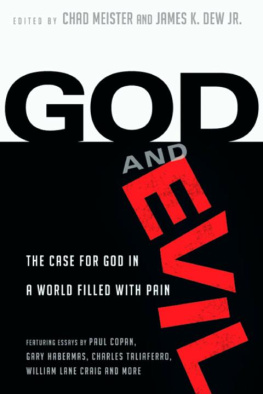Chad V. Meister James B. Stump - Original Sin and the Fall: Five Views
Here you can read online Chad V. Meister James B. Stump - Original Sin and the Fall: Five Views full text of the book (entire story) in english for free. Download pdf and epub, get meaning, cover and reviews about this ebook. year: 2020, publisher: InterVarsity Press / IVP Academic, genre: Religion. Description of the work, (preface) as well as reviews are available. Best literature library LitArk.com created for fans of good reading and offers a wide selection of genres:
Romance novel
Science fiction
Adventure
Detective
Science
History
Home and family
Prose
Art
Politics
Computer
Non-fiction
Religion
Business
Children
Humor
Choose a favorite category and find really read worthwhile books. Enjoy immersion in the world of imagination, feel the emotions of the characters or learn something new for yourself, make an fascinating discovery.
- Book:Original Sin and the Fall: Five Views
- Author:
- Publisher:InterVarsity Press / IVP Academic
- Genre:
- Year:2020
- Rating:3 / 5
- Favourites:Add to favourites
- Your mark:
- 60
- 1
- 2
- 3
- 4
- 5
Original Sin and the Fall: Five Views: summary, description and annotation
We offer to read an annotation, description, summary or preface (depends on what the author of the book "Original Sin and the Fall: Five Views" wrote himself). If you haven't found the necessary information about the book — write in the comments, we will try to find it.
Original Sin and the Fall: Five Views — read online for free the complete book (whole text) full work
Below is the text of the book, divided by pages. System saving the place of the last page read, allows you to conveniently read the book "Original Sin and the Fall: Five Views" online for free, without having to search again every time where you left off. Put a bookmark, and you can go to the page where you finished reading at any time.
Font size:
Interval:
Bookmark:

InterVarsity Press
P.O. Box 1400, Downers Grove, IL 60515-1426
Ivpress.com
2020 by James B. Stump and Chad V. Meister
All rights reserved. No part of this book may be reproduced in any form without written permission from InterVarsity Press.
InterVarsity Press is the book-publishing division of InterVarsity Christian Fellowship/USA, a movement of students and faculty active on campus at hundreds of universities, colleges, and schools of nursing in the United States of America, and a member movement of the International Fellowship of Evangelical Students. For information about local and regional activities, visit intervarsity.org.
Scripture quotations, unless otherwise noted, are from the New Revised Standard Version of the Bible, copyright 1989 by the Division of Christian Education of the National Council of the Churches of Christ in the USA. Used by permission. All rights reserved.
Cover design and image composite: David Fassett
Images: apple: Mike Kemp/Getty Images
tree: Isarapic/iStock/Getty Images Plus
ISBN 978-0-8308-5393-9 (digital)
ISBN 978-0-8308-5287-1 (print)
This digital document has been produced by Nord Compo.

J. B. STUMP AND CHAD MEISTER
Theologians throughout most of Christian history have almost universally agreed that God created the world for a good and loving purpose, which included a community of morally good human beings. It has also been almost universally agreed on that this divine plan was impeded in some significant way and that restoration was required. The commonly used term to denote this impediment is the fall, and a term often used to indicate its source is original sin. But beyond these basic claims of agreement regarding the divine plan for humanity, there has been much debate both in times past and in the present. This book examines these two important notions of original sin and the fall and explores different interpretations of them in Christian theology today. Before presenting these interpretations, some background material may be beneficial.
The traditional doctrine of the fall in Western Christian history can be traced in its developed form to Augustine in the fifth century. It is rooted in the idea that God created Adam de novo, from the dust, and Eve from Adams rib. They were created sinless and in the image of God, and sometime after the creation they disobeyed God in a garden created for them, the Garden of Eden. Because of this act of disobedience, they fell from a state of perfection and brought sin and evil into a good and perfect world. This act of disobedience (the eating of the forbidden fruit), the first act of human sinthe original sinbrought about the fall: tragic physical, social, and spiritual consequences for the entire human race. This sin and the curse it incurred by God account for the origin of pain, suffering, and death (physical and spiritual) and explain how all this evil could occur in a world that a good, loving, and all-powerful God created.
The terms original sin and fall had been used by theologians before Augustine, but he took those early, inchoate ideas and developed them into full-fledged doctrines. They are based on several key passages in the Bible, most notably very early in the book of Genesis.
In chapter three of the Genesis account of creation, the Lord God asks Adam if he had eaten from the forbidden tree. Adam acknowledges as much and places blame on Eve for enticing him, and in turn Eve blames the tempting serpent for her capitulation. In response, God curses Adam, Eve, and the serpent:
Because you have listened to the voice of your wife,
and have eaten of the tree
about which I commanded you,
You shall not eat of it,
cursed is the ground because of you;
in toil you shall eat of it all the days of your life;
thorns and thistles it shall bring forth for you;
and you shall eat the plants of the field.
By the sweat of your face
you shall eat bread
until you return to the ground,
for out of it you were taken;
you are dust,
and to dust you shall return. (Gen 3:17-19)
The text then adds the following proclamation:
Then the LORD God said, See, the man has become like one of us, knowing good and evil; and now, he might reach out his hand and take also from the tree of life, and eat, and live forevertherefore the LORD God sent him forth from the garden of Eden, to till the ground from which he was taken. He drove out the man; and at the east of the garden of Eden he placed the cherubim, and a sword flaming and turning to guard the way to the tree of life. (Gen 3:22-24)
Perhaps surprisingly, the word fall is nowhere to be found in this text. Neither is original sin. Nor are these terms found anywhere in the Bible. As with a number of important Christian doctrines, such as the doctrine of the Trinity, while the terms that were later utilized to denote the doctrines of original sin and fall are not found explicitly in the Bible, those who affirm them argue that the biblical text nevertheless points to them.
These two doctrines have endured the test of time for a number of reasons. One is their apparent interpretive perspicuity. They just seem to fit the story. Adam and Eve were created good, even very good. But they disobeyed the Lord. Thus, they were cast out of the garden and told that suffering would follow, as would death. If one connects this narrative with some of Pauls statements in the New Testamentsin came into the world through one man and one mans trespass led to condemnation for all (Rom 5:12, 18); as all die in Adam, so all will be made alive in Christ (1 Cor 15:22); and the creation was subjected to futility (Rom 8:20)it is not much of a leap to get to the traditional doctrines of original sin and fall.
Another reason for the longevity of these doctrines is the apparent explanation for the origin and universality of evil that is derived from them. They seem, at first glance at least, to provide an explanation for how there could exist a world that God created, which is filled with pain and suffering, and a mechanism for explaining how the sin of one or two human beings could permeate the entire cosmos. These doctrines are powerful indeed.
While these doctrines have received widespread acceptance in Western Christian thought throughout the centuries, concerns have also been raised about them. For example, Augustine, in his developed views on the matter, maintained that original sin was transmitted from one generation to the next through sexual intercourse. The manner in which this occurred, in his view, is due to concupiscencea theological term referring to sinful physical desire, especially sexual lust. Augustine believed that after the fall all sexual acts, even in marriage, entail concupiscence. It is through this sinful event, when a child is produced, that original sin gets passed along to the offspring from father to child. Augustine also held that original sin transmits both humanitys sinful nature and its guilt. In his account, infants are born both sinful and guilty before God. Unless they are baptized and thus regenerated through the sacrament of baptism, they will not enter heaven. Most modern theologians, both Catholic and Protestant, deny that babies are born guilty (and thus punishable) before God. So some aspects of the traditional view of original sin and the fall have passed into the annals of history.
Font size:
Interval:
Bookmark:
Similar books «Original Sin and the Fall: Five Views»
Look at similar books to Original Sin and the Fall: Five Views. We have selected literature similar in name and meaning in the hope of providing readers with more options to find new, interesting, not yet read works.
Discussion, reviews of the book Original Sin and the Fall: Five Views and just readers' own opinions. Leave your comments, write what you think about the work, its meaning or the main characters. Specify what exactly you liked and what you didn't like, and why you think so.


